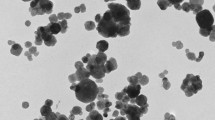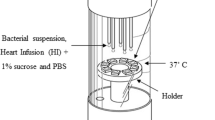Abstract
Purpose of review
This paper reviews a new method of dentin surface modification, smear layer-deproteinization for self-etch adhesive systems, particularly in relation to improving the adhesion to caries-affected dentin.
Recent Findings
Remnants of smear debris, which forms hybridized smear layer with self-etch adhesives, can prevent monomer infiltration and interfere with the chemical interaction of adhesive monomers and the underlying dentin. The hybridized smear layer weakens the physical and chemical properties of the resin-dentin hybridized complex both immediately and over time. Smear layer-deproteinization with NaOCl and HOCl solutions can improve the quality of resin-dentin interface of self-etch adhesives through elimination of the hybridized smear layer, development of monomer infiltration, and enhancement of the chemical interaction of adhesive monomers with hydroxyapatite due to an increase in the mineral/organic ratio on the dentin surface. These positive effects are influenced by the types of oxidizing solution and their application time and also depend upon the adhesive materials used because compromising effects of residual oxidized-byproducts at the dentin surface on the polymerization behavior of the adhesives are different between the materials. However, applying antioxidant/reducing agents can eliminate this problem.
Summary
Smear layer-deproteinization is more effective for improving the bonding efficacy of self-etch adhesives to caries-affected dentin than normal dentin because caries-affected dentin produces a thicker organic-rich smear layer. Smear layer-deproteinization with HOCl solution, which has a rapid and broad-spectrum antimicrobial activity with less irritating and sensitizing properties, along with the subsequent application of antioxidant/reducing agents could enhance the longevity of composite restoration with self-etch adhesives.



Similar content being viewed by others
References
Papers of particular interest, published recently, have been highlighted as: •• Of major importance
Ogata M, Harada N, Yamaguchi S, Nakajima M, Pereira PNR, Tagami J. Effects of different burs on dentin bond strengths of self-etching priming systems. Oper Dent. 2001;26:370–7.
Mahdan MHA, Nakajima M, Foxton RM, Tagami J. Combined effect of smear layer characteristics with hydrostatic pulpal pressure on dentine bond strength of HEMA-free and -containing one-step adhesives. J Dent. 2013;41:861–71.
Shinoda Y, Nakajima M, Hosaka K, Otsuki M, Foxton RM, Tagami J. Effect of smear layer characteristics on dentin bonding durability of HEMA-free and HEMA-containing one-step self-etch adhesives. Dent Mater J. 2011;30(4):501–10.
Tay FR, Pashely DH. Aggressiveness of contemporary self-etching systems. I: depth of penetration beyond dentin smear layers. Dent Mater. 2001;17:293–308.
Suyama Y, Lührs AK, De Munck J, Mine A, Poitevin A, Yamada T, et al. Potential smear layer interference with bonding of self-etching adhesives to dentin. J Adhes Dent. 2013;15:317–24.
Mine A, De Munck J, Cardoso MV, Van Landuyt KL, Poitevin A, Van Ende A, et al. Dentin-smear remains at self-etch adhesive interface. Dent Mater. 2014;30(10):1147–53.
Spencer P, Wang Y, Walker MP, Swafford JR. Molecular structure of acid-etched dentin smear layers—in situ study. J Dent Res. 2001;80:1802–7.
•• Thanatvarakorn O, Nakajima M, Prasansuttiporn T, Ichinose S, Foxton RM, Tagami J. Effect of smear layer deproteinizing on rein-dentine interface with self-etch adhesive. J Dent. 2014;42:298–304. This article demonstrate that smear layer-deproteinizing with NaOCl and HOCl solution improves quality of the resin-dentin interface of a 2-step self-etch adhesive, eliminating hybridized smear layer, in which HOCl treatment was more effective than NaOCl treatment.
•• Thanatvarakorn O, Prasansuttiporn T, Thitthaweerat S, Foxton RM, Ichinose S, Tagami J, et al. Smear layer deproteinizing improves on bonding of one-step self-etch adhesives to dentin. Dent Mater. 2018;34(3):434–41. This article clearly demonstrate that HOCl-smear layer-deproteinizing along with the subsequent application of a reducing agent improves dentin bonding of current 1-step self-etch adheisves.
Mountouris G, Silikas N, Eliades G. Effect of sodium hypochlorite treatment on the molecular composition and morphology of human coronal dentin. J Adhes Dent. 2004;6(3):175–82.
Zhou L, Wang Y, Yang HY, Guo J, Tay RF, Huang C. Effect chemical interaction on the bonding strengths of self-etching adhesives to deproteinised dentine. J Dent. 2015;43:973–80.
Kambara K, Nakajima M, Hosaka K, Takahashi M, Thanatvarakorn O, Ichinose S, et al. Effect of smear layer treatment on dentin bond of self-adhesive cements. Dent Mater J. 2012;31(6):980–7.
Wang L, Bassiri M, Najafi R, Najafi K, Yang J, Khosrovi B, et al. Hypochlorous acid as a potential wound care agent: part I. Stabilized hypochlorous acid: a component of the inorganic armamentarium of innate immunity. J Burns Wounds. 2007;6:e5.
Fukuzaki S. Mechanisms of actions of sodium hypochlorite in cleaning and disinfection processes. Biocontrol Sci. 2006;11(4):147–57.
Albrich JM, McCarthy CA, Hurst JK. Biological reactivity of hypochlorous acid: implications for microbicidal mechanisms of leukocyte myeloperoxidase. Proc Natl Acad Sci U S A. 1981;78(1):210–4.
White C. Handbook of chlorination and alternative disinfectants. New York: John Wiley & Sons, Inc.; 1999.
Abdul-Baki AA. Pitfalls in using sodium hypochlorite as a seed disinfectant in C incorporation studies. Plant Physiol. 1974;53(5):768–71.
Guentzel JL, Liang Lam K, Callan MA, Emmons SA, Dunham VL. Reduction of bacteria on spinach, lettuce, and surfaces in food service areas using neutral electrolyzed oxidizing water. Food Microbiol. 2008;25(1):36–41.
•• Kunawarote S, Nakajima M, Shida K, Kitasako Y, Foxton RM, Tagami J. Effect of dentin pretreatment with mild acidic HOCl solution on microtensile bond strength and surface pH. J Dent. 2010;38(3):261–8. This article represents the first study to highlight HOCl solution as a pretreatment agent with dentin bonding of self-etch adhesives.
Gu LS, Huang XQ, Griffin B, Bergeron BR, Pashley DH, Niu LN, et al. Primum non nocere—the effects of sodium hypochlorite on dentin as used in endodontics. Acta Biomater. 2017;61:144–56.
•• Taniguchi G, Nakajima M, Hosaka K, Iwamoto N, Ikeda M, Foxton RM, et al. Improving the effect of NaOCl pretreatment on bonding to caries-affected dentin using self-etch adhesives. J Dent. 2009;37(10):769–75. This article brings the first insight concerning smear layer-deproteinizing for bonding of self-etch adhesives to caries-affected dentin.
Lai SC, Mak YF, Cheung GS, Osorio R, Toledano M, Carvalho RM, et al. Reversal of compromised bonding to oxidized etched dentin. J Dent Res. 2001;80:1919–24.
Morris MD, Lee KW, Agee KA, Bouillaguet S, Pashley DH. Effects of sodium hypochlorite and RC-prep on bond strengths of resin cement to endodontic surfaces. J Endod. 2001;27:753–7.
Prasansuttiporn T, Nakajima M, Foxton RM, Tagami J. Scrubbing effect of self-etching adhesives on bond strength to NaOCl-treated dentin. J Adhes Dent. 2012;14(2):121–7.
•• Prasansuttiporn T, Nakajima M, Kunawarote S, Foxton RM, Tagami J. Effect of reducing agents on bond strength to NaOCl-treated dentin. Dent Mater. 2011;27(3):229–34. This article provides important information related to reversal effect of antioxidant/reducing agents on compromised bonding to NaOCl-treated dentin.
Pashely DH, Tay F, Yiu C, Hashimoto M, Breschi L, Carvalho R. Collagen degradation by host-derived enzymes during aging. J Dent Res. 2004;83:216–21.
Carrilho MR, Carvalho RM, de Goes MF, di Hipolito V, Geraldeli S, Tay FR, et al. Chlorhexidine preserves dentin bond in vitro. J Dent Res. 2007;86:90–4.
Prasansuttiporn T, Thanatvarakorn O, Tagami J, Foxton RM, Nakajima M. Bonding durability of a self-etch adhesive to normal vs smear layer-deproteinized dentin: effect of reducing agent and plant extract antoxidant. J Adhes Dent. 2017;19:253–8.
•• Nakajima M, Sano H, Burrow MF, Tagami J, Yoshiyama M, Ebisu S, et al. Tensile bond strength and SEM evaluation of caries-affected dentin using dentin adhesives. J Dent Res. 1995;74:1679–88. This article is a classical study about bonding to caries-affected dentin. It is the first study to reduce bond strength to caries-affected dentin with thick and poor hybrid layer formation.
Nakajima M, Ogata M, Okuda M, Tagami J, Sano H, Pashley DH. Bonding to caries-affected dentin using self-etching primers. Am J Dent. 1999;12:309–14.
Nakajima M, Sano H, Zheng L, Tagami J, Pashley DH. Effect of moist vs. dry bonding to normal vs. caries-affected dentin using Scotchbond multi-purpose plus. J Dent Res. 1999;78:1298–303.
Nakajima M, Sano H, Urabe I, Tagami J, Pashley DH. Bond strengths of single-bottle dentin adhesives to caries-affected dentin. Oper Dent. 2000;25:2–10.
Yoshiyama M, Tay FR, Doi J, Nishitani Y, Yamada T, Itou K, et al. Bonding of self-etch and total-etch adhesives to carious dentin. J Dent Res. 2001;81:556–60.
Ceballos L, Camejo DG, Fuentes MV, Osorio R, Toledano M, Carvalho RM, et al. Microtensile bond strength of total-etch and self-etching adhesives to caries-affected dentine. J Dent. 2003;31:469–77.
Arrais CAG, Giannini M, Nakajima M, Tagami J. Effect of additional and extended acid etching on bonding to caries-affected dentin. Eur J Oral Sci. 2004;112:458–64.
Nakajima M, Kitasako Y, Okuda M, Foxton RM, Tagami J. Elemental distributions and microtensile bond strength of adhesive interface to normal and caries-affected dentin. J Biomed Mater Res Part B: Appl Biomater. 2005;72B:268–75.
Say EC, Nakajima M, Senawongse P, Soyman M, Ozer F, Tagami J. Bonding to sound vs. caries-affected dentin using photo and dual-cure adhesive. Oper Dent. 2005;30:90–8.
Nakajima M, Hosaka K, Yamauti M, Foxton RM, Tagami J. Bonding durability of self-etching primer system to normal and caries-affected dentin under hydrostatic pulpal pressure in vitro. Am J Dent. 2006;19:147–50.
•• Nakajima M, Kunawarote S, Prasansuttiporn T, Tagami J. Bonding to caries-affected dentin. Jpn Dent Sci Rev. 2011;47(2):102–14. This review article gives valuable and detailed information related to bonding mechanism to caries-affected dentin.
Erhardt MCG, Toledano M, Osorio R, Pimenta LA. Histomorphologic characterization and bond strength evaluation of caries-affected dentin/resin interfaces: effect of long-term water exposure. Dent Mater. 2008;24:786–98.
Pashley DH, Ciucchi B, Sano H, Horner JA. Permeability of dentin to adhesive agents. Quintessence Int. 1993;24(9):618–31.
Kunawarote S, Nakajima M, Foxton RM, Tagami J. Pretreatment effect of mildly acidic hypochlorous acid on adhesion to caries-affected dentin using a self-etch adhesive. Eur J Oral Sci. 2011;119(1):86–92.
Joves GJ, Inoue G, Nakashima S, Sadr A, Nikaido T, Tagami J. Mineral density, morphology and bond strength of natural versus artificial caries-affected dentin. Dent Mater J. 2013;32:138–43.
De Carvalho FG, Puppin-Rontani J, Dos Santos RL, Carlo HL, Bonan PR, Garcia-Godoy F, et al. In vitro effect of S. mutans biofilm on fluoride/MDPB-containing adhesive system bonded to caries-affected primary dentin. Am J Dent. 2014;27(5):227–32.
Lenzi TL, Tedesco TK, Calvo AF, Ricci HA, Hebling J, Raggio DP. Does the method of caries induction influence the bond strength to dentin of primary teeth? J Adhes Dent. 2014;16(4):333–8.
Peixoto AC, Bicalho AA, Isolan CP, Maske TT, Moraes RR, Cenci MS, et al. Bonding of adhesive luting agents to caries-affected dentin induced by a microcosm biofilm model. Oper Dent. 2015;40(3):E102–11.
Nicoloso GF, Antoniazzi BF, Lenzi TL, Soares FZ, Rocha RO. Is there a best protocol to optimize bond strength of a universal adhesive to artificially induced caries-affected primary or permanent dentin? J Adhes Dent. 2016;18(5):441–6.
Follak AC, Miotti LL, Lenzi TL, Rocha RO, Soares F. Degradation of multimode adhesive system bond strength to artificial caries-affected dentin due to water storage. Oper Dent. 2018;43(2):E92–E101.
Collins CJ, Bryant RW, Hodge KL. A clinical evaluation of posterior composite resin restorations: 8-year findings. J Dent. 1998;26:311–7.
Opdam NJ, Bronkhorst EM, Roeters JM, Loomans BA. A retrospective clinical study on longevity of posterior composite and amalgam restorations. Dent Mater. 2007;23:2–8.
Kopperud SE, Tveit AB, Gaarden T, Sandvik L, Espelid I. Longevity of posterior dental restortions and reasons for failure. Eur J Oral Sci. 2012;120:539–48.
Gordan VV, Riley JL III, Geraldeli S, Rindal DB, Qvist V, Fellows JL, et al. Repair or replacement of defective restorations by dentists in the dental practice-based research network. J Am Dent Assoc. 2012;143:593–601.
Diercke K, Lussi A, Kersten T, Seemann R. Isolated development of inner (wall) caries like lesions in a bacterial-based in vitro model. Clin Oral Investg. 2009;13:439–44.
Author information
Authors and Affiliations
Corresponding author
Ethics declarations
Conflict of Interest
The authors declare that they have no conflict of interest.
Human and Animal Rights and Informed Consent
This article does not contain any studies with human or animal subjects performed by any of the authors.
Additional information
This article is part of the Topical Collection on Dental Restorative Materials
Rights and permissions
About this article
Cite this article
Hosaka, K., Prasansuttiporn, T., Thanatvarakorn, O. et al. Smear Layer-Deproteinization: Improving the Adhesion of Self-Etch Adhesive Systems to Caries-Affected Dentin. Curr Oral Health Rep 5, 169–177 (2018). https://doi.org/10.1007/s40496-018-0185-z
Published:
Issue Date:
DOI: https://doi.org/10.1007/s40496-018-0185-z




